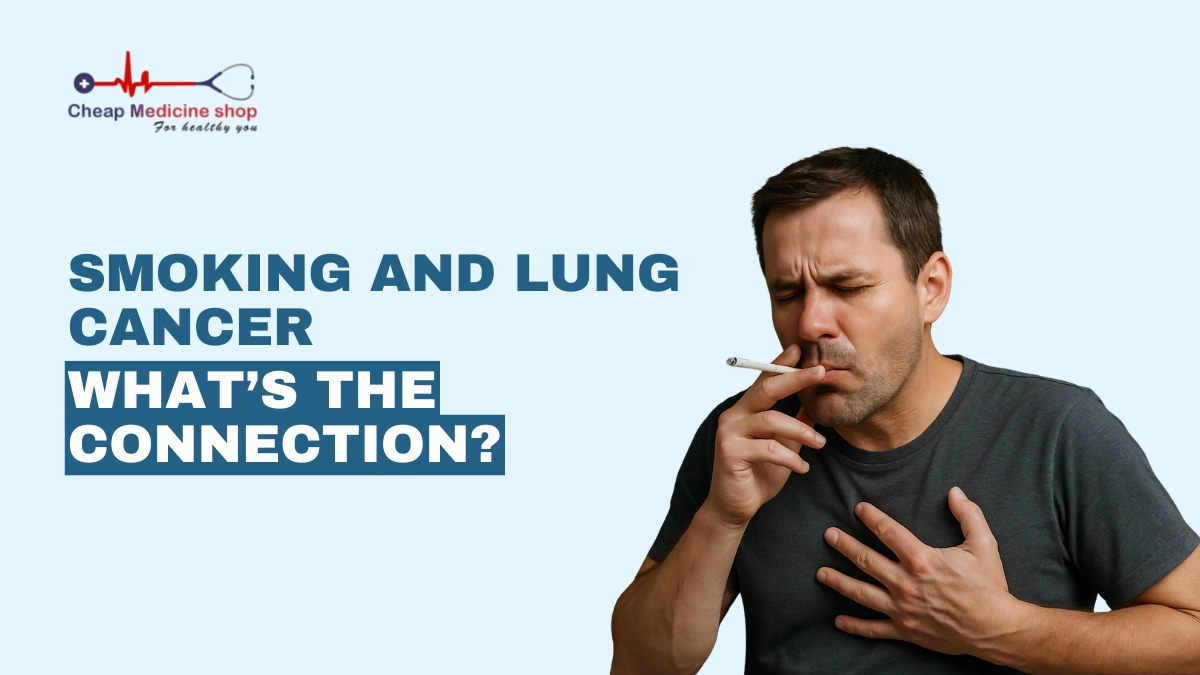Smoking is one of the leading causes of Lung Cancer, projected to affect about 226,650 people in the United States in 2025, according to the American Cancer Society.
Nearly 90% of Lung Cancer deaths are linked to smoking, which delivers thousands of toxic chemicals that damage lung tissue and trigger Cancer, even with occasional use. Each puff harms cells and increases the risk over time. Understanding this powerful connection can help with prevention and early detection.
Read on to understand the link between smoking and Lung Cancer, how it develops, and why quitting reduces risk.
Does smoking cause Lung Cancer?
Yes, Smoking can cause Lung Cancer. Every puff of cigarette smoke carries over 70 Cancer-causing chemicals deep into the lungs. These toxic substances damage the DNA inside lung cells, which controls how cells grow and repair themselves. When Deoxyribonucleic acid (DNA) is harmed, cells may multiply abnormally, creating an environment where Cancer can develop.
The destruction starts with the very first cigarette. Tar, formaldehyde, and benzene create ongoing inflammation and weaken the lungs’ natural repair systems. Over time, this repeated injury allows abnormal cells to growand develop into Lung Cancer from smoking.
Even people who have never smoked face risks. Breathing secondhand smoke exposes non-smokers to the same Cancer-causing chemicals, which can damage lung DNA and raise Cancer risk.
Studies show that Lung Cancers in smokers often have specific gene changes caused by tobacco chemicals, which differ from those in non-smokers. These changes make the cancer more aggressive and related to smoking exposure.
Save up to 90% on your medicine bills

Iressa 250 Mg Tablets

Flonida 5 % (10 gm)

Veenat 100 Mg Capsule

5FU Cbc 500 Mg Injection
Signs and symptoms to watch for
Lung Cancer grows quietly at first. Most people don’t notice any symptoms until the disease has already spread. Some warning signs need medical attention immediately, especially when they last longer than three weeks.
The most common symptoms include:
- Cough that continues or gets worse
- Coughing up blood or brownish spit
- Getting out of breath during normal activities
- Chest pain that hurts more when breathing deeply
- Losing weight without trying to diet
- Getting lung infections frequently
- Feeling tired and weak constantly
How to lower risk and protect against Cancer
The best way to prevent smoking-related Cancers is to never start smoking or to quit if you already do. Quitting can bring health benefits at any age, regardless of how long you have smoked.
Here’s how Cancer risk continues to drop over time after quitting:
- Within 5–10 years: The risk of throat, mouth, and voice box Cancers is cut in half.
- Within 10 years: Chances of developing bladder, kidney, or oesophageal Cancer drop significantly.
- Within 10–15 years: Lung Cancer risk is reduced by about 50%.
- Within 20 years of quitting: Cancer risks for most types nearly match those of someone who has never smoked.
Additional protective measures include:
- Avoiding secondhand smoke exposure: Breathing smoke from others is harmful, and no amount of exposure is considered safe.
- Testing homes for radon gas: This invisible radioactive element causes significant non-smoker Cancer cases.
- Eat nutritious foods: Include vegetables, fruits, nuts, and whole grains rich in antioxidants to support lung health and protect cells from damage caused by toxins.
- Engaging in regular physical activity: Exercise strengthens the immune system function.
- Implementing workplace safety measures: Proper ventilation and protective equipment reduce toxin exposure.
Treatment for smoking-related Lung Cancer
Treating Lung Cancer depends on the type, stage, and overall health of the patient. Early diagnosis significantly improves outcomes, so knowing the warning signs is crucial. Treatment options typically include:
- Surgery: For patients with localized tumors, surgical removal of the affected lung tissue may be possible. Procedures range from removing a small section of the lung (lobectomy) to more extensive resections if necessary.
- Radiation therapy: Radiation uses high-energy rays to destroy cancer cells. It is often recommended for tumors that cannot be removed surgically or to shrink tumors before surgery.
- Chemotherapy: Medications target rapidly growing cancer cells throughout the body. Chemotherapy may be used alone or combined with surgery or radiation, depending on the stage of Lung Cancer.
- Targeted therapy: Some Lung Cancers caused by smoking carry specific genetic mutations. Targeted drugs focus on these mutations to slow cancer growth while reducing harm to normal cells.
- Immunotherapy: This treatment helps the body’s immune system recognize and attack cancer cells. It may be suitable for advanced stages or for patients who do not respond well to other treatments.
Conclusion
Smoking and Lung Cancer share a strong cause-and-effect relationship, accounting for nearly 90% of deaths linked to the disease. Even occasional smoking increases risk, while quitting can reduce it significantly over time.
Early detection is critical, as treatment options, such as surgery, radiation, chemotherapy, targeted therapy, and immunotherapy, are more effective in the initial stages. Recognizing warning signs like persistent cough, unexplained fatigue, or breathlessness can lead to timely diagnosis and better outcomes.
In combination with quitting smoking, adopting a healthy lifestyle, and monitoring environmental exposures, these measures provide the best protection for lung health and long-term survival.
Frequently Asked Questions
Is Lung Cancer common in non-smoking females?
Yes. Lung Cancer is increasingly seen in non-smoking females due to genetic changes, hormonal influences, and exposure to secondhand smoke or pollutants like radon and air pollution. Early detection and awareness improve chances of better treatment outcomes in this group. outcomes.
Can Lung Cancer be prevented by vaccinations?
No, there are currently no vaccines that prevent Lung Cancer. Prevention focuses on avoiding risk factors like smoking and harmful exposures; however, vaccines exist for some viruses linked to other Cancers.
Does air pollution contribute to Lung Cancer risk for smokers?
Yes, air pollution adds to Lung Cancer risk, especially among smokers whose lung capacity is already compromised. Pollutants like fine particulate matter and chemicals further damage lung tissue and promote Cancer development.
Does Lung Cancer cause back pain?
Yes, Lung Cancer can cause back pain if the Cancer spreads to the bones near the spine. Persistent, unexplained back pain alongside breathing or coughing problems should be evaluated for possible Cancer.
How accurate are Lung Cancer screening tests for detecting early disease?
Low-dose CT scans detect 80–90% of early Lung Cancers in high-risk patients. False positives can occur in 10–20% of cases, so follow-up tests may be needed. Screening is still valuable for early detection and improving outcomes.
Cheap Medicine Shop only refers to credible, authoritative sources for our content. If you’re curious about how we ensure the integrity of our content, we encourage you to read our Content Information Policy.














